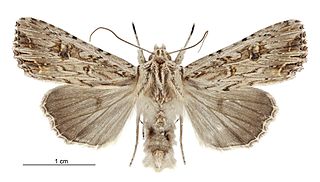
Ichneutica lignana is a moth of the family Noctuidae. It is endemic to New Zealand. This species is found on the Three Kings Islands as well as the North, South and Stewart Islands. This species lives in a variety of habitats including coastal areas, tussock grasslands, shrublands, and native forest, at a range of altitudes from sea level to over 1300 m. I. lignana is quite distinctive in appearance with its dark markings on the abdomen and forewings although it is possible to confuse Ichneutica morosa, Meterana pansicolor and Meterana pascoi with this species. Adults are on the wing throughout the year in the northern parts of the New Zealand but are restricted to the months of October to April in the more southern parts of the country.

Ichneutica semivittata is a moth of the family Noctuidae. It is endemic to New Zealand. It can be found from the Three King Islands down to Stewart Island. The similar species I. sulcana can be distinguished from I. semivittata as the former is much larger, has a darker hindwing and abdomen and has only one to three spots located behind the middle of the forewing in comparison to the 8 or 9 of I. semivittata. This species lives in a variety of habitats from open grasslands to clearings in forest and at a range of altitudes from the sea level to the alpine zone. Larval host species include Juncus procera, Carex secta as well as on tussock grasses such as Poa cita, P. colensoi and Festuca novae-zelandiae. Adults of this species are on the wing from August to April and are attracted to light.

Ichneutica petrograpta is a moth of the family Noctuidae. This species is endemic to New Zealand where it is found in the southwest districts of the South Island, including Westland, Otago Lakes and Fiordland. It is very similar in appearance to I. mutans. It inhabits tussock and shrubland in the alpine to subalpine zones. Adults of I. petrograpta are on the wing from December to February and are attracted to sugar traps. The life history of this species is unknown as are the host species of its larvae.

Ichneutica oliveri is a moth of the family Noctuidae. It is endemic to New Zealand, found only in the South Island. However it has not been observed on the eastern side of that island from mid-Canterbury southwards to Southland. This species is distinctive and is unlikely to be confused with other closely related species. It inhabits tussock grasslands, shrubland as well as granite sand plains, all in the alpine zone. Adults are on the wing from December to March and are attracted to light. They have been observed feeding on the flowers of Hebe species. The life history of this species is unknown as are the larval hosts.
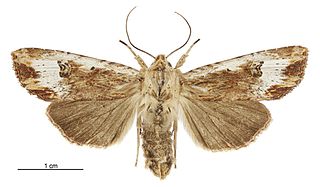
Ichneutica rubescens is a moth of the family Noctuidae. It is endemic to New Zealand. This species can be found locally in the North Island but is widespread throughout the South Island and is present on both Stewart Island and the Auckland Islands. I. rubescens has a round or oval mark near the centre of the forewing that encloses a dot. This is diagnostic of this species. I. rubescens inhabits tussock grasslands, beech as well as podocarp forests. Larval hosts are likely herbaceous plants such as grasses and herbs and larvae have been reared on Gunnera prorepens. Adults of this species are on the wing from December to April and are attracted to light.
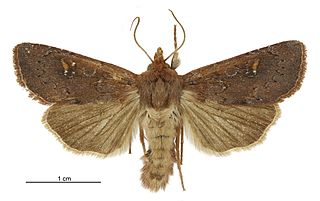
Ichneutica alopa is a moth of the family Noctuidae. It is endemic to New Zealand and is found in the central and southern parts of the North Island as well as in the South Island. It inhabits tussock grasslands and wetlands and can occur at ranges from the alpine zone down to almost sea-level. The life history of this species is unknown as are the host species of its larvae in the wild. Larvae of this species have been raised in captivity on Sphagnum moss as well as on species in the genus Raoulia. Adults of this species are on the wing from late January to April and are attracted to light and to sugar traps. I. alope can be confused with I. agorastis, I. micrastra or I. sapiens but the latter three species can be distinguished externally from I. alope through differences in size, forewing pattern and the antennae of the male of the species.

Ichneutica propria is a moth of the family Noctuidae. It is endemic to New Zealand. This species is only known from Tongariro National Park and Pureora Forest in the North Island but is widespread in the South Island. I. propria might be confused with faded I. atristriga, however the later species lacks the distinctive marking on the prothorax nor does it have the black mark running through the middle of the forewing. It is very common and widespread in montane to alpine grassland areas. Although the larvae have yet to be described, they have been reared on Poa cita and Festuca novae-zelandiae and are known to feed on introduced grass species. The adults of this species are on the wing from December to mid May and are attracted to light.
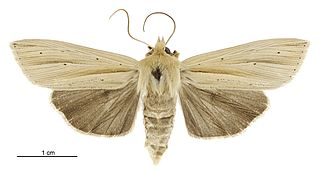
Ichneutica sulcana, the dark underwing wainscot, is a moth of the family Noctuidae. It is endemic to New Zealand and can be found throughout the North, South and Stewart Islands at a range of altitudes from the lowlands to the alpine zone. This species prefers to live in native grass, shrub and wetland habitats as well as in native forest. The larval host plants of this species are forest grasses and sedges and larvae have been reared on Microlaena avenacea and species within the genus Carex. The larva pupates in the soil. Adults are on the wing from December to May but have also been recorded in August and September in the northern parts of the North Island. They are attracted to sugar traps as well as to light. I. sulcana and I. supersulcana are very similar in appearance but can be distinguished as there are differences in the male abdomen and genitalia of the two species. Also these two species do not appear to share a range as I. supersulcana seems to prefer to live at higher altitudes than I. sulcana. I. sulcana might also be confused with I. semivittata but I. sulcana is a larger species with a much darker abdomen and hindwing, and has only 1 to 3 dots on the forewing postmedian line.

Ichneutica toroneura is a moth of the family Noctuidae. It is endemic to New Zealand. This species is similar to I. unica but can be distinguished from that species by the uniform black vein markings on the forewings of I. toroneura. It is also similar in appearance to I. acontistis but the base of the forewings of I. toroneura lack the dark stripe that can be found on the forewings of I. acontistis. The males of I. toroneura have longer pectinations on their antennae. I. toroneura is found in the centre of southern South Island in the tussock grasslands of Central Otago and the Mackenzie Basin. Larvae feed on tussock grasses Poa cita and Festuca novae-zelandiae. Adults are on the wing from November to January.

Ichneutica paraxysta is a moth of the family Noctuidae. It is endemic to New Zealand. This species is very similar in appearance to its close relative I. acontistis but as the range of the two species do not overlap this is unlikely to cause confusion. I. paraxysta is only found in the North Island at the subalpine zones in the Mount Taranaki region and at Mount Ruapehu. It prefers tussock grassland and shrubland habitat. The life history of this species is unknown as are the host species of its larvae however it has been hypothesised that the larval host plants are species in the genera of Poa and Festuca.
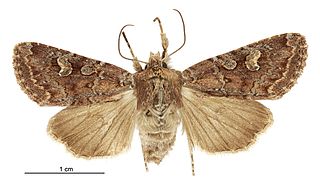
Ichneutica agorastis is a moth of the family Noctuidae. This species is endemic to New Zealand. This moth is similar in appearance to two other species in the genus but can be distinguished through the colour and size of its forewings. This species is found in the South Island and Stewart Island in open habitats in the subalpine zone. However, in Southland I. agorastis can be found down to sea-level. Adult moths are on the wing between January and April. The life history and host species are unknown.

Ichneutica cuneata is a moth in the family Noctuidae. It is endemic to New Zealand. I. cuneata is found in and around the Tongariro National Park in the North Island and throughout the South Island. Specimens found in Tongariro National Park tend to be darker in appearance than South Island specimens but as their colour is variable, and antennae and genitalia of both species are consistent, they are not now regarded as a separate species. I. cuneata inhabits tussock grasslands and shrublands in alpine and subalpine zones. The adults are on the wing from December to April and can be found flying during the day. The life history of I. cuneata is unknown as are the specific host species of its larvae. However larvae of I. cuneata are said to feed on herbaceous plants. The adults of this species also pollinate native species such as Myosotis macrantha.
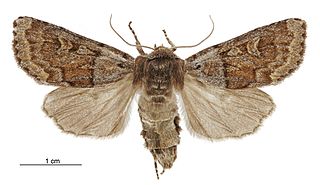
Ichneutica marmorata is a moth of the family Noctuidae. This species is endemic to New Zealand and can be found in the North Island at the Tongariro National Park and at Puketitiri near the Kaweka Range. In the South Island it is widespread. It prefers alpine to subalpine habitat but occurs down to sea level altitudes in more southern locations. Adults are on the wing from late October to February. Larvae of this species may use tussock grasses in the genus Chionochloa as their host and they have been reared on Festuca novae-zelandiae.

Ichneutica disjungens is a moth of the family Noctuidae. This species is endemic to New Zealand and can be found on the central volcanic plateau of the North Island and in the eastern as well as the south western parts of the South Island. I. disjungens inhabits tussock grasslands in the alpine and subalpine zones. The hosts of the larvae of this species include Poa cita, P. colensoi, and Festuca novae-zelandiae. The adults of this species are distinctive and are unlikely to be confused with other species. They are on the wing between October and March.
Ichneutica dundastica is a moth of the family Noctuidae. This species is endemic to New Zealand. As at 2019 this species has only been found near the Dundas Hut in the Tararua Range near Wellington. It inhabits alpine shrubland and is attracted to light. The life history of this species is unknown as are the host species of its larvae however adults are on the wing from late November to early December. The female of the species is larger and more conspicuous than the male.
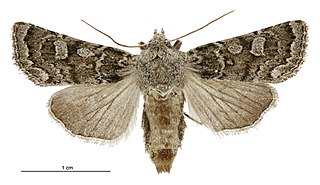
Ichneutica sistens is a moth of the family Noctuidae. This species is endemic to New Zealand. It can be found in the central North Island and throughout the South Island, although it is more common on the eastern side of that latter Island. It is very variable in both colour and size. I. sistens prefers open habitat such as tussock grasslands, dunes and braided rivers. Larval host species include grasses in the family Poaceae and include species in the genera Rytidosperma and Elymus, as well as Poa cita and Agrostis capillaris. Adults are on the wing from January to May and are attracted to light.

Ichneutica paracausta is a moth of the family Noctuidae. This species is endemic to New Zealand. It is found locally in the central North Island, is widespread in the South Island and can also be found in Stewart Island. I. paracausta is variable in colour, but as it has a distinctive black streak on its forewing as well as a wing pattern that is characteristic, I. paracausta is unlikely to be confused with other species. It is present on the North Island volcanic plateau as well as Little Bush Reserve in Hawkes Bay in the North Island as well as in tussock grassland, alpine and subalpine shrubland and in alpine forest. Larvae have been recorded as feeding on grasses, a pupa has been found in a cocoon under the bark of a tree and adult moths are on the wing from October to January.
Ichneutica haedifrontella is a moth of the family Noctuidae. This species is endemic to New Zealand. It is only known from scattered areas in the North and South Islands. In the North Island it has only been collected in the Pouakai Range in Taranaki. In the South Island it is known from the Nelson, Buller, North Canterbury, Otago Lakes and Fiordland regions. It inhabits alpine to subalpine zones. The life history of this species is unknown as are the host species of its larvae in the wild. Larvae have been reared on species in the Chionochloa genus. Adults are on the wing from December to February and are attracted to light. This species has a smaller dwarf form that can be found in the Pouakai Range and at Dart Hut.

Ichneutica infensa is a moth of the family Noctuidae. This species is endemic to New Zealand. It is found throughout the North and South Islands but appears to be rarely seen or collected in the north and west parts of the North Island. As at 2019 the northern limit to the range of this species is Titirangi. I. infensa inhabits tussock grasslands and native forest. Larvae are nocturnal and its host plants are in the genus Carex including Carex solandri. Larvae have also been raised on Bromus catharticus. Adults of this species are on the wing from late October to February. Adults are narrow winged with patterns on the forewings that are relatively distinctive. However this species can possibly be confused with I. inscripta.
Ichneutica inscripta is a moth of the family Noctuidae. This species is endemic to New Zealand. This species is found from south Auckland to Taranaki in the North Island. It prefers to inhabit dense native forest with high rainfall at higher altitudes. The life history of this species is unconfirmed as are the host species of its larvae but is likely to be similar to its close relative I. infensa. This species is very similar in appearance to its close relative I. infensa but has more strongly patterned forewings. The adults of this species are on the wing from late October to January.
















